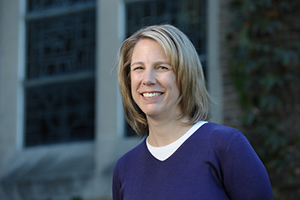 Christina Wolbrecht
Christina Wolbrecht
Christina Wolbrecht, associate professor of political science, C. Robert and Margaret Hanley Family Director of the Notre Dame Washington Program, and director of the Rooney Center for the Study of American Democracy at the University of Notre Dame, teaches and writes about American politics, political parties, women and politics, and American political development. Now at work on a study of the first 100 years of women as voters in American politics, she is co-author, with J. Kevin Corder, of the recently published book Counting Women’s Ballots: Female Voters from Suffrage through the New Deal.
How would you describe the research and scholarship you pursue?
I am a scholar of American politics, particularly gender and politics and political parties. I have written, and continue to write, on such topics as whether, how, and with what consequences women cast their ballots after suffrage to the present day, whether the presence of female politicians inspires women and girls to greater political engagement, and why political parties adopt particular policy positions on such issues as women’s rights and education policy.
What influence is gender likely to exert in the 2016 presidential election?
Gender always matters in American elections. Our expectations for political leaders, particularly presidents, are “gendered,” from the personality characteristics we expect them to display to the issues on which we expect them to have expertise. Our electoral landscape is gendered, with men more likely to put themselves forward as candidates and to hold political office and with women more likely to turn out to vote and to vote for Democrats.
In 2016, many of the gendered aspects of elections have been front and center. What has been perhaps most surprising is that the centrality of gender is not entirely due to the fact that we likely will see the nomination of a woman for president by a major political party for the first time in American history. Donald Trump’s articulation of a particularly assertive, even domineering, masculinity has been a central aspect of his campaign for the Republican nomination and soon for the presidency itself. The impact of these two factors remains to be seen. For example, while Democrats have had an important advantage among women in recent presidential elections, that advantage has not been enormous and is shaped by other factors such as marital status and race. In almost any other election, we would expect for voters’ party identification to trump (sorry!) their gender. Will that be the case in 2016?
Having extensively studied the effects of women’s votes in the five presidential elections since women’s suffrage, which effect seems to you the most remarkable?
In our new book, J. Kevin Corder and I are able to offer new insights into how women used their ballots in the first five presidential elections after the ratification of the 19th Amendment in 1920. One of the more interesting findings concerns the New Deal realignment, the period of elections in the 1930s when, in response to the Great Depression, Democrats replaced Republicans as the majority party in the United States. Much has been written about the political coalition Democrats put together to become the majority party, but women are rarely mentioned. Yet, we find that women contributed more new voters — voters who had never voted before — to the new Democratic majority than did men.
This is perhaps not surprising. Because many women did not initially take advantage of their new right, there were simply more women available to cast ballots for the first time in the 1930s. At the same time, women who had voted in the 1920s were more likely to switch from casting Republican ballots to casting Democratic ballots in the 1930s. The combination of those two sources of female Democratic voters — women who had never voted before and women who had previously voted Republican — meant that by the end of the 1930s, Democrats owed more than half of their new support to women. For a group denied electoral influence for so very long, this is an impressive feat.
Originally published at news.nd.edu.